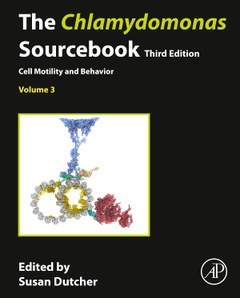Description
The Chlamydomonas Sourcebook (3rd Ed.)
Volume 3: Cell Motility and Behavior
Coordinator: Dutcher Susan
Language: English
Subjects for The Chlamydomonas Sourcebook:
Keywords
?Acorn; Actin; Adhesion; Assembly factor; Asymmetries; Axonemal dynein; Axoneme; BBSome; CAMP; Cartwheel; Central apparatus; Central pair; Centrioles; Channelrhodopsin; Chaperone; Chlamydomonas; Cilia; Ciliary assembly; Ciliary disassembly; Ciliary resorption; Cilium; Cryo-EM; Cryo-electron microscopy; Cryo-electron tomography; Cytokinesis; Deciliation; Docking; Duplication; Dynein; Dyneins; Electron microscopy; Expansion microscopy; Eyespot assembly and placement; Eyespot proteins; FAP57; Flagella; Flagellar associated proteins; Flagellum; Gliding; IFT; IFT dynein/dynein-1b; IFT proteins; IFT transport; Intraflagellar transport; Kinesin; Kinesin-2; Length control; Light induced ciliary responses; MIA; Mass spectrometry; Mating; Membrane; Microtubule depolymerization; Microtubules; Motile; Motility; Motility regulation; Multiple morphological abnormalities of the sperm flagellum; Multisubunit assembly; Myosin; Nucleoside kinase diphosphate; Phosphorylation; Photophobic/photoshock response; Photoreceptor current and signaling; Phototactic sensitivity; Phototaxis; Polystyrene microspheres; Post-translational protein modification; Preassembly; Primary ciliary dyskinesia; Protein kinases; Protein transport; Radial spokes; Septin; Superresolution; Surface motility; Tether-head; Trafficking; Transition zone; Tubulin; Y-links
470 p. · 17.7x25.4 cm · Hardback
Description
/li>Contents
/li>Biography
/li>Comment
/li>
The Chlamydomonas Sourcebook, 3rd Edition
Cell Motility and Behavior (Volume 3)
The gold-standard reference?introducing this multidisciplinary science,?fully revised and updated with the latest discoveries
Originally published as the standalone Chlamydomonas Sourcebook, then expanded as the third volume in a three-part comprehensive gold-standard reference,?The Chlamydomonas Sourcebook: Cell Motility and Behavior has been fully revised and updated to include the wealth of new resources for the Chlamydomonas community. Reflecting the significant advancement in?the understanding of the role of basal bodies and cilia play in human diseases, this volume employs quantitative proteomics and mass spectroscopy as well as?cryo?EM tomography and single particle?cryo?EM. Other topics such as current insights?on?mitosis and cytokinesis, ciliary assembly and motility, intraflagellar?transport, and more help build an understanding of human diseases of the cilium.
Cell Motility and Behavior presents the latest in research and best practices, making this a must-have resource for researchers and students working in plant science and photosynthesis, fertility, mammalian vision, and biochemistry; crop scientists; plant physiologists; and plant, molecular, and human disease biologists.
1. Landmark Contributions of Chlamydomonas to Understanding Cilia 2. Basal bodies 3. Transition Zone 4. Dynein 5. Axonemal Dynein Preassembly 6. Ciliary Radial Spokes 7. Central pair 8. N-DRC 9. MIPS 10. Asymmetries 11. The Chlamydomonas ciliary membrane and its dynamic properties 12. Physics and mechanics of ciliary beating 13. IFT 14. Length control 15. Ciliary Disassembly 16. Deciliation 17. The Eyespot and Behavioral Light Responses 18. Ciliary adhesion and cilium-generated signaling during fertilization 19. Cytoskeleton
- Provides an essential reference to a model species for the study of mechanisms of motility in free living cells?
- Includes methods for Chlamydomonas motility research?
- Includes a table listing the known proteins (with NCBI accession numbers) for each structure discussed, and the known mutations that affect each structure and process
These books may interest you

Handbook of Dynein (Second Edition) 171.15 €

CiliaDevelopment and Disease 178.41 €

CiliaDevelopment and Disease 56.31 €

